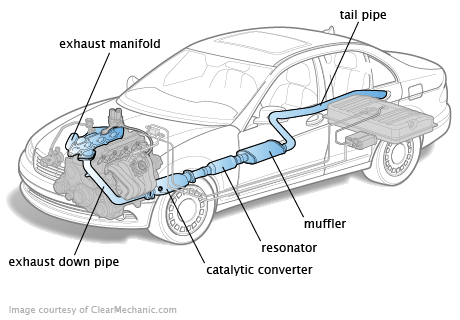Help Your
Fuel Economy & the Environment
This post may contain affiliate links
If you’re driving down the road and you notice a quiet car in front of you, you should know that the car’s exhaust system is doing its job. A well-maintained exhaust system is essential in making your ride safe and sound. If your exhaust system is working correctly, it benefits your fuel consumption and the environment. Read on to know more about the critical things you need to know about car exhausts.
What does a car exhaust do?
The exhaust system helps in reducing noise from the engine to help make the components of the exhaust system work together. Aside from noise reduction, the exhaust system provides a gateway for the exhaust gases to come out. You know for a fact that when a car is in transit, it produces harmful gases to humans and the environment; an exhaust system will help filter these toxic gases, namely nitrogen monoxide, carbon monoxide and nitrogen oxide.
Below are
the components of an exhaust system:
Exhaust Pipes
An exhaust
pipe carries the gas and exits through the tailpipe. These pipes are usually
made of stainless steel because it can resists corrosion compared to the other
types of steel. It’s crucial to ensure that there are no holes in the pipe
because it may emit fumes that are harmful to health and the environment.
Muffler
Exhausts reduce the noise from engines through mufflers. It tones down the engine noise to an adequate level. A car’s combustion process is a progression of explosions that will create sound. Also, If the gap between the two valves is too big, they will open and close late, lowering power and producing more noise. (Check the Livingston & Heaven Express store for an authorized Humphrey Valve distributor). Mufflers usually baffle to help bounce the noise from the exhausts. Today, some mufflers are made of fiberglass to absorb the noise coming from the combustion effectively.
Resonator
The
resonator works similarly as the muffler; it converts sound vibrations to
reduce engine noise. It also helps in efficiently improving exhaust flow. The
resonator can be found before or after the muffler.
Exhaust Manifold
The exhaust
manifold is always connected to the cylinder head. It combines each of the
exhaust cylinders into one pipe. The exhaust manifold helps collect all exhaust
gases and directs it to the exhaust pipe. Exhaust manifolds are often made of
steel or iron.
Catalytic Converter
The catalytic
converter looks like a muffler, but it helps transform hydrocarbons and carbon
monoxide to carbon dioxide and water vapor. Some catalytic converters are also
capable of reducing nitrogen oxides. Although the resulting chemicals from the
conversion are still harmful to the environment, they are less damaging.
Oxygen Sensor
The oxygen
sensor is mounted inside the exhaust pipe close to the exhaust manifold. Today,
almost all fuel-injected cars use an oxygen sensor to monitor the oxygen in the
exhaust. The car’s computer system can easily add or subtract fuel to come up
with efficient fuel usage.
Corrosion is
one of the common problems of a car’s exhaust system. If possible, choose parts
made of high-quality materials to ensure that your car’s exhaust system
performs its job well. Always schedule an exhaust system maintenance if you
notice that rust is beginning to get into the exhaust system; seek help from a
professional. It cannot be stressed enough about the dangers of inhaling these
toxic gases from the car’s combustion. Be a responsible car owner, and ensure
the safety of the people around you and the environment.
The post Tech: What You Need to Know About Your Exhaust System first appeared on Clean Fleet Report.
Source: Clean Fleet Report
